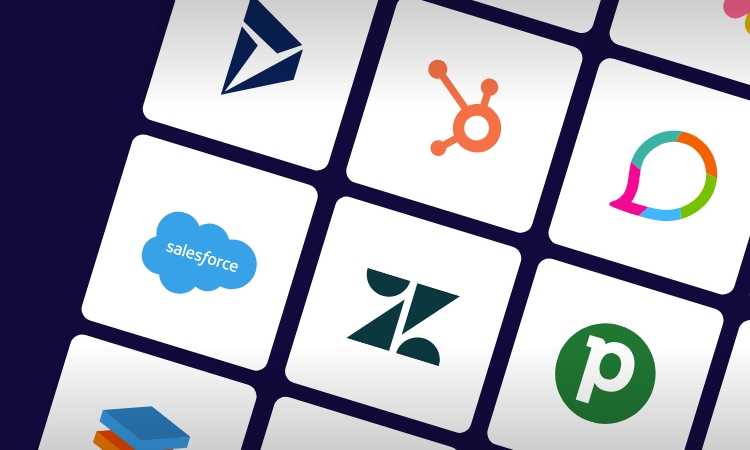E-commerce Integrations: 2024 & Beyond!
Explore the latest trends in e-commerce integration to enable future-proof e-commerce automation and exceptional customer experiences.
The world of digital commerce keeps exponentially growing and rapidly evolving. One of the most effective strategies for modern businesses to stay competitive involves implementing e-commerce integrations to accelerate digital transformation and enable process automation.
What are e-commerce integrations?
E-commerce integrations are a cornerstone strategy for modern businesses looking to digitally transform and automate business processes. It involves equipping e-commerce businesses with the ability to swiftly and seamlessly connect the latest SaaS, cloud apps, and trends to their tech stack while enabling real-time data exchange and process automation.
On a basic level, e-commerce integrations help businesses enable data synchronization, enhance inventory management, diversify sales channels, improve product information optimization, customer relationship management, and much more. This could involve implementing a next-gen, API-driven integration platform to connect an e-commerce platform with other systems such as ERP, PIM, WMS, marketplace channels, marketing automation systems, and more.
On a larger level, this helps businesses streamline business operations, elevate customer experiences, unify and leverage data from multiple systems effectively, and adopt an API-led approach. Most importantly, it prepares them to implement any new technology or software to the tech stack without loss of data integrity.
Modern businesses are already redefining how they stay ahead of the curve and competition by adopting several key e-commerce integration trends such omni channel commerce, composable commerce, headless commerce, e-commerce automation, and more.
On a basic level, e-commerce integrations help businesses enable data synchronization, enhance inventory management, diversify sales channels, improve product information optimization, customer relationship management, and much more. This could involve implementing a next-gen, API-driven integration platform to connect an e-commerce platform with other systems such as ERP, PIM, WMS, marketplace channels, marketing automation systems, and more.
On a larger level, this helps businesses streamline business operations, elevate customer experiences, unify and leverage data from multiple systems effectively, and adopt an API-led approach. Most importantly, it prepares them to implement any new technology or software to the tech stack without loss of data integrity.
Modern businesses are already redefining how they stay ahead of the curve and competition by adopting several key e-commerce integration trends such omni channel commerce, composable commerce, headless commerce, e-commerce automation, and more.
Become omni channel!
The future of cross-platform digital commerce
Omni channel (often mistaken for multi-channel) involves integrating multiple online and offline sales, marketing, and customer support channels and devices in order to deliver a unified customer experience. This includes integrating multiple channels such as web shops, brick-and-mortar stores, social media, mobile applications, smart devices, and more, enabling customers to seamlessly transition between each of these integrated touchpoints in real-time, while experiencing a consistent brand experience.
Omni channel experiences have revolutionized and enabled the increasingly interconnected world of e-commerce. It has also redefined how other industries such as manufacturing, healthcare, banking, travel, and hospitality are benefiting customers with integrated commerce experiences. Explore everything you need to know about omni channel!
Omni channel experiences have revolutionized and enabled the increasingly interconnected world of e-commerce. It has also redefined how other industries such as manufacturing, healthcare, banking, travel, and hospitality are benefiting customers with integrated commerce experiences. Explore everything you need to know about omni channel!
Headless commerce
A revolution in e-commerce
As consumer expectations continue to evolve at a rapid pace, being agile and adaptable is key to staying ahead of emerging trends and catering to new demands. However, many businesses in the e-commerce industry were, and continue to be, held back by their monolithic platforms with tightly coupled systems which make it extremely difficult to implement changes and adapt to customer needs.
In this competitive climate, headless commerce emerged as a strategic move for businesses to achieve unparalleled speed and innovation and outpace the competition. At its core, headless commerce is a separation of the front end and back end of an e-commerce system, allowing for greater flexibility in both areas and empowering businesses to stay ahead in the digital commerce race.
Discover everything you need to know about headless commerce and why it has become the new industry standard.
In this competitive climate, headless commerce emerged as a strategic move for businesses to achieve unparalleled speed and innovation and outpace the competition. At its core, headless commerce is a separation of the front end and back end of an e-commerce system, allowing for greater flexibility in both areas and empowering businesses to stay ahead in the digital commerce race.
Discover everything you need to know about headless commerce and why it has become the new industry standard.
E-commerce automation
A necessity to accelerate digital commerce
In the fast-paced and rapidly evolving world of e-commerce, one of the most essential strategies for modern online retailers to stay ahead of the competition and to be future-proof is e-commerce automation. It has helped redefine customer experiences, marketing initiatives, accessibility of customer support, and overall business efficiency. Even repetitive yet crucial manual e-commerce functionalities such as personalization, real-time inventory management, order fulfillment, and cross-channel accessibility, are now being streamlined by e-commerce automation. Powered by the integration of SaaS solutions, cloud apps, artificial intelligence, and machine learning algorithms, e-commerce automation empowers data-driven decision-making, cost savings, and the ability to meet the ever-evolving demands of the digital world.
Discover what e-commerce automation is, how it works, and how businesses can go about implementing or improving their e-commerce automation strategy!
Discover what e-commerce automation is, how it works, and how businesses can go about implementing or improving their e-commerce automation strategy!
Composable commerce
The key to achieving e-commerce flexibility
As consumer expectations continue to evolve at a rapid pace, being agile and adaptable is key to staying ahead of emerging trends and catering to new demands. However, many e-commerce businesses are held back by their monolithic platforms with tightly coupled systems, which make it extremely difficult to implement changes and adapt to customer needs.
Composable Commerce is a way for e-commerce businesses to create more meaningful, intuitive, and convenient product experiences for their customers through a careful selection of best-of-breed technologies. This approach empowers businesses to create unique and personalized e-commerce experiences, drive growth, and stay competitive in the ever-evolving digital landscape.
Learn all there is to know about Composable Commerce in our blogs!
Composable Commerce is a way for e-commerce businesses to create more meaningful, intuitive, and convenient product experiences for their customers through a careful selection of best-of-breed technologies. This approach empowers businesses to create unique and personalized e-commerce experiences, drive growth, and stay competitive in the ever-evolving digital landscape.
Learn all there is to know about Composable Commerce in our blogs!
Check out our webinar on Composable Commerce
This webinar is the first episode of our series “Alumio Talks,” in which our speakers, Caspar Hardholt, CEO, and Reza Vinkes, Partner Manager, discuss the hot topic of Composable Commerce, debunk popular myths around it and share common “composable” challenges.
MACH architecture
The flexible architecture that is reshaping the future of e-commerce
MACH architecture isn't a concept that emerged overnight. It is the result of years of evolution in the tech and e-commerce industries. Some years ago, e-commerce companies gradually realized that their “all-in-one” enterprise e-commerce platforms were bogging them down, as they could not deal with the newfound digital customer demands. The answer to overcoming the limitations inherent in monolith e-commerce platforms? MACH architecture, a flexible approach characterized by its agility, its customer-centric focus, and, above all, is future-proof nature.
Discover everything you need to know about MACH and why it has become the new industry standard.
Discover everything you need to know about MACH and why it has become the new industry standard.
Mobile commerce
Mobile commerce, or m-commerce, has emerged as a transformative force in the digital era, reshaping the e-commerce landscape.
In 2023, mobile commerce sales reached $2.2 trillion, making up 60 percent of all e-commerce sales worldwide. As such, it is no secret that this burgeoning digital trend holds the key to expanding into new markets and engaging younger generations.
Mobile Commerce: What is it and Why Does it Matter?
Learn everything there is to know about mobile commerce and adopt a mobile-first mentality that can position your business as an integral part of the consumer's digital existence! Explore the following topics:
What is Mobile Commerce?
Which mobile commerce technologies are relevant in 2023?
How to utilize mobile commerce in your e-commerce digitization journey?
E-commerce solutions
A guide to essential SaaS and cloud app integrations and the best integration methods
The success and expansion of e-commerce businesses and their capabilities greatly depend on the e-commerce SaaS (Software as a Service) solutions and cloud apps they choose to integrate. There are a plethora of e-commerce platforms like Shopify, Spryker, and BigCommerce for businesses to build holistic online stores. At the same time, there are more e-commerce solutions like PIM systems, payment gateways, and marketing automation software. E-commerce businesses can benefit from integrating CRM and ERP solutions to improve operations, inventory management, and logistics.
However, while integrating these e-commerce solutions helps enhance online stores greatly, building these integrations is significantly more challenging. This is why modern e-commerce businesses are turning to cloud-based integration platforms to connect their online stores with software solutions in a way that facilitates synchronization, real-time data exchange, and workflow automation between connected systems.
Explore the essentials of e-commerce integrations, software solutions to integrate for e-commerce from modern CRMs to payment gateways, and the different types of integration platforms to implement for future-proof growth.
However, while integrating these e-commerce solutions helps enhance online stores greatly, building these integrations is significantly more challenging. This is why modern e-commerce businesses are turning to cloud-based integration platforms to connect their online stores with software solutions in a way that facilitates synchronization, real-time data exchange, and workflow automation between connected systems.
Explore the essentials of e-commerce integrations, software solutions to integrate for e-commerce from modern CRMs to payment gateways, and the different types of integration platforms to implement for future-proof growth.
Want to see Alumio in action?



























































